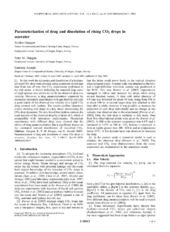| dc.contributor.author | Gangstø, Reidun | eng |
| dc.contributor.author | Haugan, Peter Mosby | eng |
| dc.contributor.author | Alendal, Guttorm | eng |
| dc.date.accessioned | 2005-06-02T12:15:57Z | |
| dc.date.available | 2005-06-02T12:15:57Z | |
| dc.date.issued | 2005-05-24 | eng |
| dc.Published | Geophysical Research Letters 2005 32 L10612 | en |
| dc.identifier.issn | 0094-8276 | en_US |
| dc.identifier.uri | https://hdl.handle.net/1956/682 | |
| dc.description.abstract | In this work the dynamics and dissolution of a hydratecovered CO2 drop were studied, using a numeric model and data from one of very few CO2 experiments performed in the real ocean. A theory including the standard drag curve of rigid spheres was shown not to fit the observed drop rise velocity. However, a drag parameterization supported by numerous laboratory experiments with gas bubbles provides a good match of the observed rise velocity of a liquid CO2 drop covered with hydrate. The results confirm laboratory results showing that shape is a key factor determining the CO2 drop dynamics. We also found that hydrate reduces the mass transfer of the observed drop by a factor of 2, which is compatible with laboratory experiments. Numerical experiments with different drop sizes showed that the choice of drag parameterization has a significant impact on the estimated vertical distribution of dissolved CO2. | en_US |
| dc.format.extent | 296112 bytes | eng |
| dc.format.mimetype | application/pdf | eng |
| dc.language.iso | eng | eng |
| dc.publisher | American Geophysical Union | en_US |
| dc.title | Parameterization of drag and dissolution of rising CO2 drops in seawater | en_US |
| dc.type | Journal article | |
| dc.identifier.doi | https://doi.org/10.1029/2005gl022637 | |
